
Royal Charles was an 80-gun first-rate three-decker ship of the line of the English Navy. She was built by Peter Pett and launched at Woolwich Dockyard in 1655, for the navy of the Commonwealth of England. She was originally called Naseby, named in honour of Sir Thomas Fairfax's decisive 1645 victory over the Royalist forces during the English Civil Wars. She was ordered in 1654 as one of a programme of four second rates, intended to carry 60 guns each. However, she was altered during construction to mount a complete battery of guns along the upper deck, and so was reclassed as a first rate.
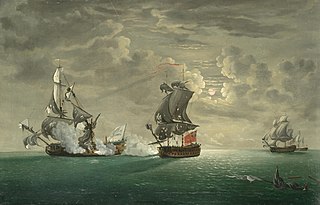
HMS Monmouth was a 66-gun third-rate ship of the line of the Royal Navy, and was likely named for James, Duke of Monmouth. She served from 1667 to 1767, winning ten battle honours over a century of active service. She was rebuilt a total of three times during her career—each time effectively becoming a completely new ship.

HMS Royal Oak was a 74-gun third-rate ship of the line of the Royal Navy, built by Jonas Shish at Deptford and launched in 1674. She was one of only three Royal Navy ships to be equipped with the Rupertinoe naval gun. Life aboard her when cruising in the Mediterranean Sea in 1679 is described in the diary of Henry Teonge.
HMS Somerset was a three-decker 80-gun third rate ship of the line of the Royal Navy, launched at Chatham Dockyard on 31 May 1698. She was the first ship to bear the name.

HMS Duke was a 90-gun second-rate ship of the line of the Royal Navy, launched on 13 June 1682 at Woolwich Dockyard.

HMS Prince was a 100-gun first rate ship of the line of the Royal Navy, built by Phineas Pett the Younger at Deptford Dockyard and launched in 1670.

HMS Royal Sovereign was a 100-gun first rate ship of the line of the Royal Navy, built at Woolwich Dockyard and launched in July 1701. She had been built using some of the salvageable timbers from the previous Royal Sovereign, which had been destroyed by fire in 1697.
HMS Royal Oak was a 100-gun first rate ship of the line of the Royal Navy, launched in 1664 at Portsmouth Dockyard. Royal Oak was built by John Tippetts, Master-Shipwright at Portsmouth 1660-8, who later became Navy Commissioner and subsequently Surveyor of the Navy.

HMS Royal James was a 102-gun first rate ship of the line of the Royal Navy, built by Anthony Deane at Portsmouth Dockyard at a cost of £24,000, and launched on 31 March 1671.
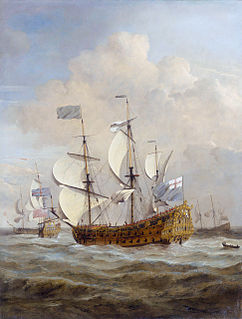
HMS St Andrew was a 96-gun first-rate ship of the line of the Royal Navy, built at Woolwich Dockyard under the supervision of Christopher Pett until his death in March 1668, completed by Jonas Shish, and launched in 1670. Commanded by George Churchill, she took part in the 1692 victory over the French navy at Barfleur & La Hogue.

HMS Edgar was a 72-gun third rate ship of the line of the Royal Navy, built by Baylie of Bristol and launched in 1668. The diarist and naval administrator Samuel Pepys visited the town during its construction, noting that in his opinion, "it will be a fine ship". By 1685 she was carrying 74 guns.
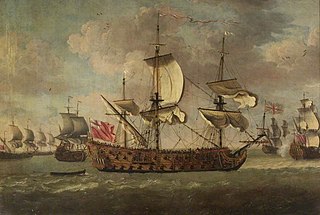
HMS Swiftsure was a 70-gun third-rate ship of the line of the Royal Navy, built by Sir Anthony Deane at Harwich, and launched in 1673. By 1685 she had been reduced to a 66-gun ship.

The Prince Royal was a 55-gun royal ship of the English Royal Navy.
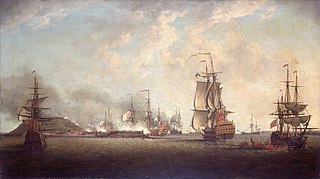
HMS Neptune was a 90-gun second-rate ship of the line of the Royal Navy. She was built under the 1677 "Thirty Great Ships" Programme and launched in 1683 at Deptford Dockyard.

HMS Captain was a 70-gun third rate built at Woolwich Dockyard in 1677/78. After sitting in Ordinary for ten years she was in active commission for the War of the English Succession fighting at Beachy Head and Barfleur. She was in Ordinary until 1706 when she was rebuilt. She was in active commission for the last half of the War of Spanish Succession but fought in no major engagements. She was at the Battle of Passero I 1718. She was rebuilt in 1720/22. She made two forays in to the Baltic though the bulk of her late career was spent as guardship at Portsmouth. She was hulked in 1740 and finally broken in 1762.
HMS Burford was a 70-gun third rate ship of the line built at Woolwich Dockyard in 1677/79 as part of the Thirty Ships Programme of 1677. She fought in the War of the English Succession, including the Battle of Barfleur, before being rebuilt at Deptford in 1699, remaining as a 70-gun third rate. During the War of Spanish Succession she was mostly in the Mediterranean fleet and fought at the capture of Gibraltar and the Battle of Málaga in 1704 before being extensively repaired between 1710 and 1712 at Portsmouth Dockyard. Burford served in the Baltic in 1715 and 1717 before returning to the Mediterranean to fight the Spanish at the Battle of Cape Passaro in 1718. She was wrecked on the Italian coast in a storm on 14 February 1719.

HMS Expedition was a 70-gun third-rate ship of the line built at Portsmouth Dockyard in 1677/79. She was in active commission during the War of the English Succession participating in the battles of Beachy Head and Barfleur. She was rebuilt in 1699. Again, for the War of Spanish Succession she was in commission for the operation at Cadiz then returned to England where she sat for two years. She was in the Mediterranean for the Battle of Marbella in 1705. She then went to the West Indies and fought in Wager’s action off Cartagena in 1708. She was rebuilt in 1709-14 to the 1706 Establishment. She spent her time split between the Baltic and as guard ship at Portsmouth before being broken at Portsmouth in 1736. She was rebuilt in 1736/40 at Deptford Dockyard.
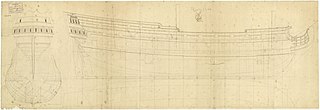
HMS Kingston was a 60-gun fourth-rate ship of the line of the Royal Navy, built by Frame in Hull and launched on 13 March 1697. She had an eventful career, taking part in numerous engagements.
HMS Torbay was an 80-gun third rate ship of the line of the Royal Navy, launched at Deptford Dockyard on 16 December 1693. In 1707, she served as flagship of Rear-Admiral of the Blue Sir John Norris and belonged to Admiral Sir Cloudesley Shovell's fleet. She saw action during the unsuccessful Battle of Toulon and was present during the great naval disaster off the Isles of Scilly when Shovell and four of his ships were lost, claiming the lives of nearly 2,000 sailors. Torbay suffered little to no damage and finally managed to reach Portsmouth.
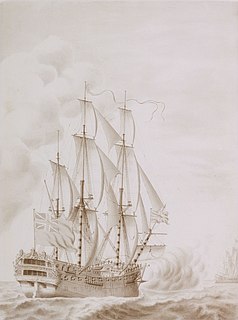
HMS Burford was a 70-gun third rate ship of the line of the Royal Navy, built at Deptford Dockyard to the 1719 Establishment, and launched on 19 July 1722. Burford was notably the early posting of both John Forbes and John Byng, both of whom rose to become Admirals.

















